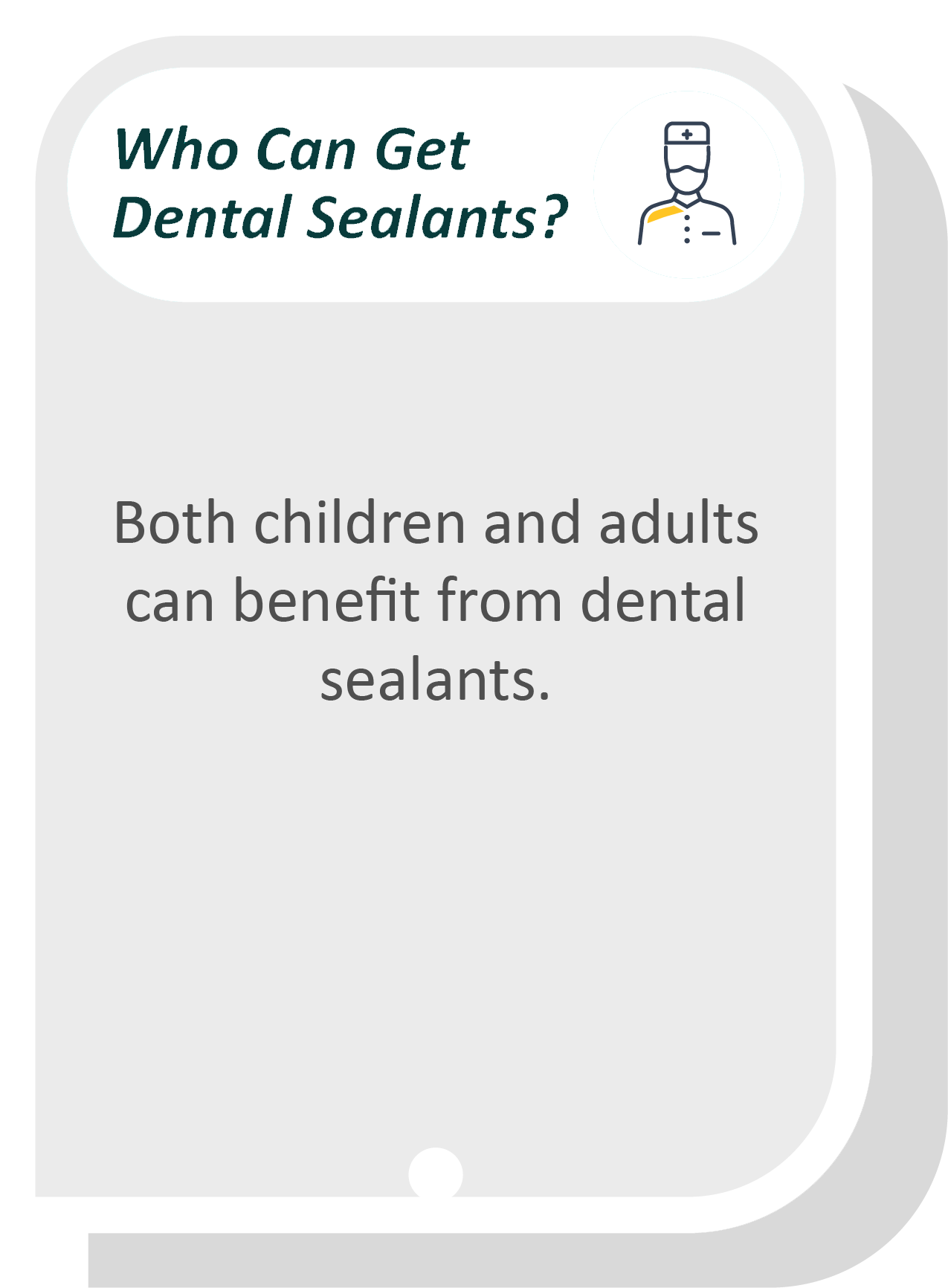Dental Sealants Los Angeles, CA
Bacteria love to find all the nooks and crannies in teeth, especially in the back teeth used to chew. In addition to brushing and flossing, dental sealants provide another layer of protection. This thin plastic coating fills and adheres to the chewing surface of the teeth to help prevent cavities.
Dental sealants are available at Vatan Dental Group in Los Angeles and the surrounding area. Our staff can discuss the procedure and answer any questions. Call us at (310) 906-1300 to learn more and schedule an appointment.
The Details About Dental Sealants
Dental sealants are thin plastic that is bonded to the tooth surface as additional protection again tooth decay. This protective coating helps keep bits of food out of the grooves of the teeth and stops bacteria and acid from settling there. According to the American Dental Association, sealants prevent 80% of cavities in the back teeth.
Dental sealants have been used successfully for more than 40 years and continue to grow in popularity. Research shows children who do not get sealants are more than twice as likely to get cavities than children who have sealants. The American Dental Association and the American Academy of Pediatric Dentistry recommend this procedure for all children.
“Dental sealants have been used successfully for more than 40 years and continue to grow in popularity.”
The Right Age For Dental Sealants
Children and adults can both benefit from dental sealants. However, the earlier a patient gets dental sealants, the better. Patients can receive dental sealants as soon as their permanent molars erupt. The first set of molars typically erupt around age six or seven, while the second set usually comes around age 12 or 13.
We recommend sealing these teeth as quickly as possible to help teeth remain cavity-free from the beginning. While dental sealants are usually best for permanent molars and premolars, some baby teeth may also benefit from sealants. Baby teeth with many grooves are more susceptible to decay and may require dental sealants to protect them from decay and premature tooth loss.
“Patients can receive dental sealants as soon as their permanent molars erupt.”
Advantages and Disadvantages of Dental Sealants
Dental sealants are a great way to protect teeth against decay. The CDC has reported that children between the ages of six to 11 without sealants have about three times the amount of first molar cavities than children with sealants. Since dental sealants usually cover the teeth at the back of the mouth, they are not visible when speaking or smiling. This simple preventative approach can improve oral hygiene and save patients time and money in the long run by avoiding more costly treatments like fillings and crowns.
While there are many advantages to receiving dental sealants, there are some disadvantages that patients should consider. While sealants can protect healthy teeth or teeth with minor decay, they cannot cover dental fillings or decayed teeth. People should also consider durability, as dental sealants are not a permanent solution to decay prevention. Sealants will wear down over time, necessitating replacement after about five years. However, when placed correctly, some sealants can last up to nine or 10 years.
“This simple preventative approach can improve oral hygiene and save patients time and money in the long run by avoiding more costly treatments like fillings and crowns.”
Check out what others are saying about our dental services on Yelp: Dental Sealants in Los Angeles, CA
The Dental Sealant Procedure
The procedure used to apply dental sealants is quick and painless. First, the teeth are cleaned and dried. We will then apply an acidic gel to the tooth surface to help create a strong bond between the tooth and the sealant. Once the gel is rinsed off and the teeth dried again, the sealant is applied to the grooves of the chewing surface. A special curing light hardens the sealant onto the tooth.
We will also check the surface for any problems. If any issues are present, the sealant may be touched up or reapplied. Then we will rinse the newly sealed teeth clean. There are no known side effects from the procedure and no eating or drinking restrictions after treatment.
“The procedure used to apply dental sealants is quick and painless.”
Questions Answered on This Page
Q. What are dental sealants? Are they growing in popularity?
Q. How are dental sealants applied?
Q. What does it feel like after sealants are applied?
Q. What's the right age to get sealants?
Q. What are some of the advantages and disadvantages of dental sealants?
People Also Ask
Q. What are composite fillings?
Q. Why should I see a family dentist?
Q. Why dental checkups are important?
Q. What foods can cause cavities?
Q. What kind of treatments do kid-friendly dentists provide?
The Post-Sealant Experience
There may be some slight discomfort when the sealants are first applied as the child gets used to having an additional layer of material on their back teeth. Some children complain of a feeling of not being able to fit their back teeth together. The thin film will feel like it's a part of the actual tooth within a day or so.
Other reactions include complaining of an odd taste immediately after sealant application. Usually, a good rinse or a sip of a flavored drink will help eliminate the taste. Our team will help address any issues or concerns after the sealants are applied.
“There may be some slight discomfort when the sealants are first applied as the child gets used to having an additional layer of material on their back teeth.”
Frequently Asked Questions
Q. Are dental sealants safe?
A. Dental sealants are safe and effective for patients. While some people may be concerned about bisphenol A (BPA) exposure, according to the American Dental Association (ADA), the amount is so minimal that there is no health concern. Patients get more exposure from food, drinks, sunscreen, and cosmetics.
Q. Do dental sealants hurt?
A. Getting a dental sealant does not hurt. Patients may notice the dental sealants on their teeth at first. However, this is temporary as people will adapt to the new feeling and not notice them anymore.
Q. How should I take care of my sealants?
A. Brushing and flossing remain important even when sealants are present. We also recommend that patients avoid chewy, sticky, or hard foods and snacks. Patients with sealants should also have regular dental check-ups to ensure that they are still effective and do not need replacing.
Q. Are there any side effects associated with dental sealants?
A. No. The only known side effect associated with dental sealants is an allergic reaction to the sealant material. This allergy is not common, but patients can have an allergy test beforehand as a precaution.
Q. How do dental sealants look on teeth?
A. Dental sealants are thin plastic coatings that help smooth out the rough surfaces of back teeth. They can be clear, tinted, or white. While sealants can be visible on teeth, they are not usually visible since they are at the back of the mouth.
Dental Terminology
Helpful Related Links
- American Dental Association (ADA). Glossary of Dental Clinical Terms. 2024
- American Academy of Cosmetic Dentistry® (AACD). Home Page. 2024
- WebMD. WebMD’s Oral Care Guide. 2024
About our business, license, and website security
- Vatan Dental Group was established in 2012.
- We accept the following payment methods: American Express, Cash, Check, Discover, MasterCard, and Visa
- We serve patients from the following counties: Los Angeles County
- We serve patients from the following cities: Los Angeles, Inglewood, Westchester, Marina del Rey, Playa del Rey, Playa Vista, Culver City, Fox Hills, Hawthorne, El Segundo and Santa Monica
- CA (License #49259). View License Information and Specifics
- National Provider Identifier Database (1740278662). View NPI Registry Information
- Norton Safe Web. View Details
- Trend Micro Site Safety Center. View Details
Back to top of Dental Sealants
















